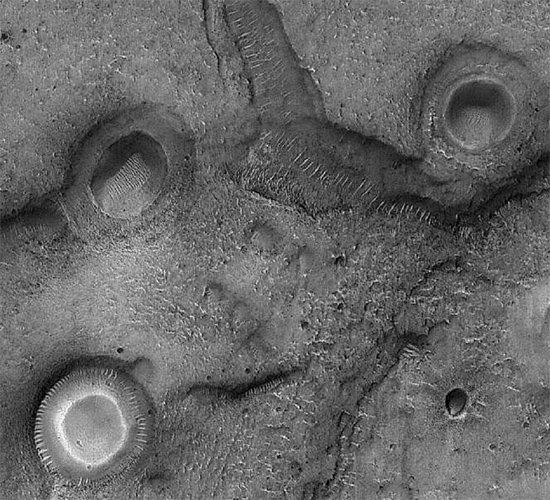According to a recent
press release, a theory
about how the planet Mars acquired
its red color, as well as its barren
desiccation has been proposed. Dr.
John Brandenburg, co-author of “Dead
Mars, Dying Earth," suggests that a
nuclear explosion—albeit a natural
one—destroyed Mars almost 200
million years ago.
Brandenburg's theory is based on
two regions of increased radiation
that appear to have been caused by
processes that once took place here
on Earth, as well. In Franceville,
Gabon, scientists noticed that there
was an unexpected three-thousandth
of a percent difference between
expected values of uranium 235
compared to uranium 238 in their
spectrographic analyses of rock
samples.
It was suggested that two billion
years ago, a self-sustaining chain
reaction began in some mineral
deposits containing uranium 235 in
concentrations over three percent.
Particular isotopes of xenon gas in
the uranium deposits in the "Oklo
reactor" region of Gabon are said to
indicate that a natural nuclear
burned for thousands of years until
the fissile uranium was exhausted.
Brandenburg says that the
"natural explosion" on Mars was more
like a blast and not a reactor. The
million megaton atomic detonation is
supposed to have scattered
radioactive dust from Mare Acidalium
all over the planet. The increased
detection of xenon 129 isotope
radiation is supposed to confirm the
connection between Gabon and Mars.
Several factors in both the Gabon
and Mare Acidalium theories, might
lend themselves to other
explanations when the time of both
observations is adjusted. Rather
than 200 million, or two billion
years, what if both anomalies were
created in the same more recent
events.
Burned and blasted craters, along
with piles of scorched dust cover
almost an entire hemisphere of Mars.
Gigantic trenches across its scarred
face could indicate that lightning
thousands or millions of times more
energetic than we know today
devastated Mars.
Electric Universe advocates have
suggested many times in these pages
that electric arcs could have
sculpted what we see on Mars. Valles
Marineris, Olympus Mons, the vast
900 kilometer crater in Argyre
Planitia, the terraced mounds in
Arabia Terra, as well as both
Martian poles demonstrate strong
support for the electric discharge
theory. In other articles, those
powerful electric discharges on Mars
were theorized to have transmuted
silicon into iron and reformed
silicon dioxide rock layers into the
vast fields of hematite spherules
that litter the landscape.
If electricity can transmute
elements, then isotopic ratios, no
matter which elements are
considered, cannot be used to prove
or disprove the timeframe of any
radiative emissions.
Past Pictures of the Day deal
with geological formations all over
the world and with craters exceeding
100 kilometers in diameter. In some
cases, there are glass spherules or
large chunks of pure silica lying in
broken pieces all over the area.
What could account for kilometers
long fields of broken glass shards
like those in Egypt or large sheets
of “Darwin
glass” from Australia? It
could have been plasma discharges in
the form of lightning bolts and
electric arcs that melted and fused
the soils into glass. The timeframe
is probably impossible to determine
with any accuracy at this late date.
Intense ionizing radiation most
likely bombarded Earth and Mars at
some time in the recent past. Rather
than nuclear reactors in the ground
it was electricity from space that
left its imprint.
Stephen Smith
Hat tip to Thane Hubbell
 New
DVD
New
DVD
The Lightning-Scarred
Planet Mars
A video documentary that could
change everything you thought you
knew about ancient times and
symbols. In this second episode of
Symbols of an Alien Sky, David
Talbott takes the viewer on an
odyssey across the surface of Mars.
Exploring feature after feature of
the planet, he finds that only
electric arcs could produce the
observed patterns. The high
resolution images reveal massive
channels and gouges, great mounds,
and crater chains, none finding an
explanation in traditional geology,
but all matching the scars from
electric discharge experiments in
the laboratory. (Approximately 85
minutes)
Video Selections
Order Link





 New
DVD
New
DVD

